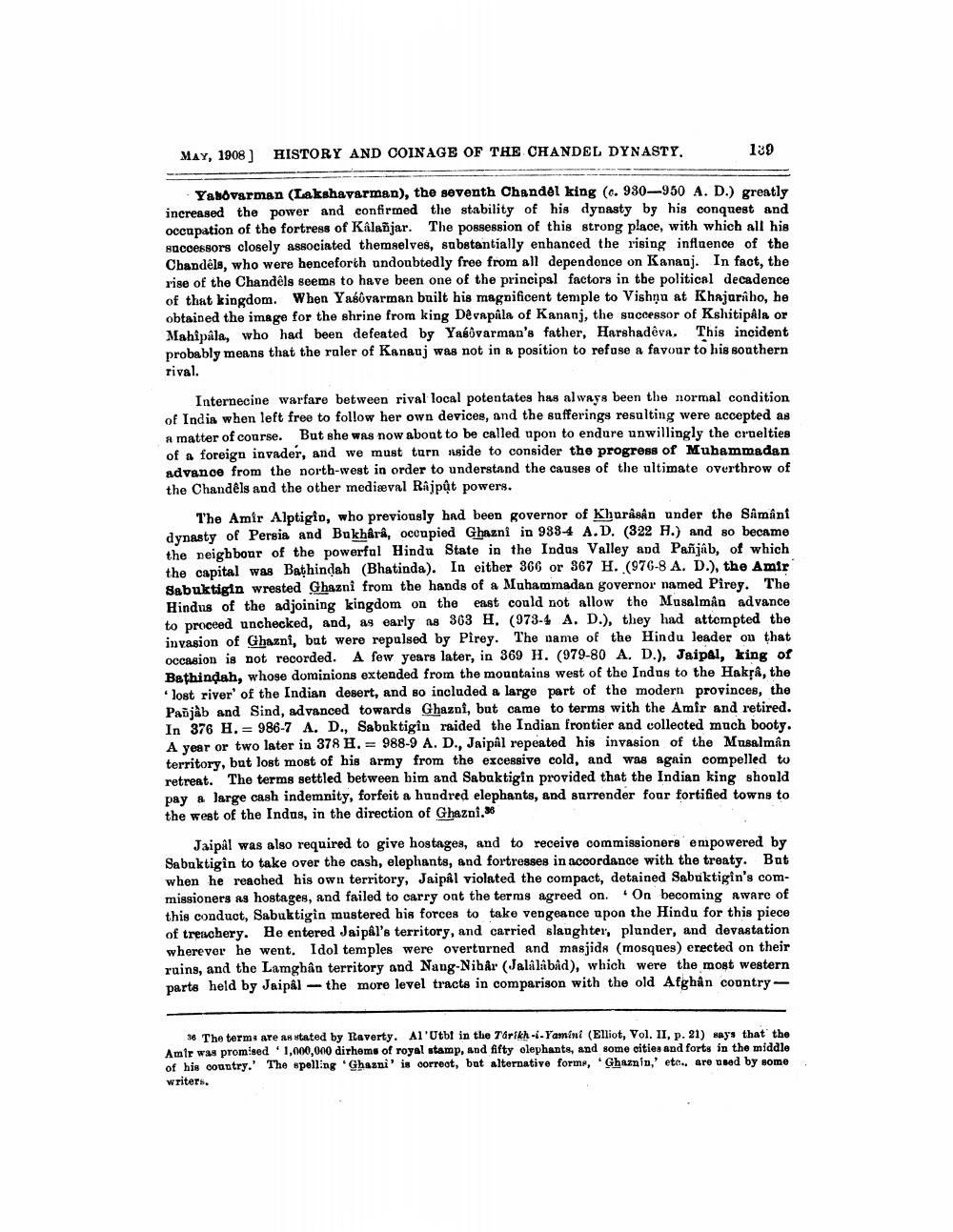________________
MAY, 1908) HISTORY AND COINAGE OF THE CHANDEL DYNASTY.
139
Yahoverman (Lakshavarman), the seventh Chandel king (c. 930-950 A. D.) greatly increased the power and confirmed the stability of his dynasty by his conquest and occupation of the fortress of Kâlaħjar. The possession of this strong place, with which all his sacoessors closely associated themselves, substantially enhanced the rising influence of the Chandels, who were henceforth undoubtedly free from all dependence on Kananj. In fact, the rise of the Chandels seems to have been one of the principal factors in the political decadence of that kingdom. When Yasovarman built his magnificent temple to Vishnu at Khajuraho, he obtained the image for the shrine from king Devapila of Kananj, the successor of Kshitipâla or Mahipala, who had been defeated by Yasovarman's father, Harshadêva. This incident probably means that the raler of Kanauj was not in a position to refuse a favour to his southern rival.
Internecine warfare between rival local potentates has always been the normal condition of India when left free to follow her own devices, and the sufferings resulting were accepted as a matter of course. But she was now about to be called upon to endure unwillingly the cruelties of foreign invader, and we must turn aside to consider the progress of Muhammadan advance from the north-west in order to understand the causes of the ultimate overthrow of the Chandels and the other medieval Rajpật powers.
The Amir Alptigio, who previously had been governor of Khurasan under the Samant dynasty of Persia and Bukhârâ, occupied Ghazni in 988-4 A.D. (322 H.) and so became the neighbour of the powerful Hindu State in the Indus Valley and Pañjab, of which the capital was Bathindah (Bhatinda). In either 366 or 367 H. (976-8 A. D.), the Amir Sabuktigin wrested Ghazni from the hands of a Muhammadan governor named Pirey. The Hindus of the adjoining kingdom on the east could not allow tho Musalman advance to proceed unchecked, and, as early as 363 H. (973-4 A. D.), they had attempted the invasion of Ghazni, but were repulsed by Pirey. The name of the Hindu leader on that occasion is not recorded. A few years later, in 369 H. (979-80 A. D.), Jaipal, king of Bathindah, whose dominions extended from the mountains west of the Indus to the Haksa, the
lost river of the Indian desert, and so included a large part of the modern provinces, the Panjab and Sind, advanced towards Ghazni, but came to terms with the Amir and retired. In 376 H. = 986-7 A. D., Sabuktigin raided the Indian frontier and collected much booty. A year or two later in 378 H. = 988-9 A. D., Jaipal repeated his invasion of the Musalman territory, but lost most of his army from the excessive cold, and was again compelled to retreat. The terms settled between him and Sabaktigin provided that the Indian king should pay a large cash indemnity, forfeit a hundred elephants, and surrender four fortified towns to the west of the Indus, in the direction of Ghazni.
Jaipal was also required to give hostages, and to receive commissioners empowered by Sabuktigin to take over the cash, elephants, and fortresses in accordance with the treaty. But when he reached his own territory, Jaipâl violated the compact, detained Sabriktigin's commissioners as hostages, and failed to carry ont the terms agreed on. On becoming aware of this conduct, Sabuktigin mustered his forces to take vengeance upon the Hindu for this piece of treachery. He entered Jaipal's territory, and carried slaughter, plunder, and devastation wherever he went. Idol temples were overturned and masjids (mosques) erected on their ruins, and the Lamghân territory and Nang-NibÅr (Jalalabad), which were the most western parts held by Jaipal - the more level tracts in comparison with the old Afghan country -
36 The terms are as stated by Raverty. Al'Utbf in the Tarikh-i-Yamini (Elliot, Vol. II, p. 21) ways that the Amir was promised 1,000,000 dirhems of royal stamp, and fifty clephants, and some cities and forts in the middle of his country. The spelling 'Ghazni' is correct, but alternative forms, Ghaznin,' etc., are used by some writers.




